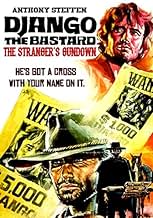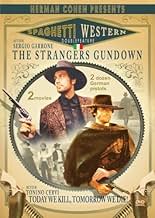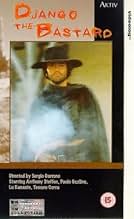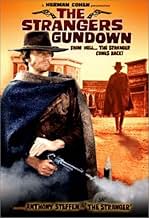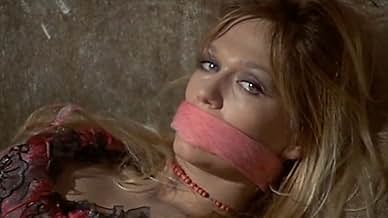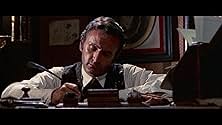IMDb RATING
6.1/10
1.4K
YOUR RATING
A mysterious stranger appears to take terrifying revenge on former Confederate officers who during the Civil War betrayed and were responsible for the massacre of their unit.A mysterious stranger appears to take terrifying revenge on former Confederate officers who during the Civil War betrayed and were responsible for the massacre of their unit.A mysterious stranger appears to take terrifying revenge on former Confederate officers who during the Civil War betrayed and were responsible for the massacre of their unit.
- Director
- Writers
- Stars
Luciano Rossi
- Hugh Murdok
- (as Lu Kamante)
Thomas Rudy
- Rowland
- (as Tomas Rudi)
Artemio Antonini
- Hawkins Henchman
- (uncredited)
Ettore Arena
- Murdok Henchman
- (uncredited)
Fortunato Arena
- Murdok Henchman
- (uncredited)
Bruno Ariè
- Hawkens Henchman
- (uncredited)
Ennio Balbo
- Storekeeper
- (uncredited)
Ugo Ballester
- Town Businessman
- (uncredited)
Omero Capanna
- Shotgun
- (uncredited)
- Director
- Writers
- All cast & crew
- Production, box office & more at IMDbPro
Featured reviews
I've read alot about "Django The Bastard" and comparisons between it and Eastwood's "High Plains Drifter". I think it's safe to say that "HPD" is not a remake of "DTB" but is is also safe to say that it at least served as the inspiration for Clint's 1972 film IMHO.
I had high expectations for "Django The Bastard" and I was definitely NOT let down. It's an at times crude and low budget affair but it has enough action, tension and chills to make it a terrific little film that just may be one of the trendsetters in the Euro Gothic Western sub-genre. The atmosphere is thick in this creepy movie and Director Sergio Garrone goes all out showing us some unique camera angles which run the full spectrum from overhead shots to close-ups to fade-in's to handheld. Very effective as is the score which at certain times is eerie enough to raise a goosebump or two. Some remarkable scenes as mentioned in other reviews including a creepy opening that is almost completely silent except for the howling wind and the memorable scene in the graveyard.
Really wonderful stuff from the little SW that could. The performances are fine and I think that anyone who is a fan of Eastwood's "High Plains Drifter" owes it to himself or herself to check this one out. It's available on DVD from VCI under it's U.S. title of "The Strangers Gundown". Easily one of my favorite Westerns.
I had high expectations for "Django The Bastard" and I was definitely NOT let down. It's an at times crude and low budget affair but it has enough action, tension and chills to make it a terrific little film that just may be one of the trendsetters in the Euro Gothic Western sub-genre. The atmosphere is thick in this creepy movie and Director Sergio Garrone goes all out showing us some unique camera angles which run the full spectrum from overhead shots to close-ups to fade-in's to handheld. Very effective as is the score which at certain times is eerie enough to raise a goosebump or two. Some remarkable scenes as mentioned in other reviews including a creepy opening that is almost completely silent except for the howling wind and the memorable scene in the graveyard.
Really wonderful stuff from the little SW that could. The performances are fine and I think that anyone who is a fan of Eastwood's "High Plains Drifter" owes it to himself or herself to check this one out. It's available on DVD from VCI under it's U.S. title of "The Strangers Gundown". Easily one of my favorite Westerns.
Sergio Garrone's "Django Il Bastardo" aka. "Django The Bastard" of 1969 is referred to by many as a great, creepy and particularly original Spaghetti Western. I am a Spaghetti Western enthusiast, and although "Django The Bastard" is certainly not a bad film, it is in my opinion overrated by many of my fellow fans of the Italian Western. Furthermore it is neither the only, nor the first, nor the best Spaghetti Western with Horror elements. This film also has the reputation of being the inspiration to Clint Eastwood's great "High Plain's Drifter" of 1973, and it might be true that parts of this movie inspired Eastwood, but "Django the Bastard" does in no way reach the quality and style of Eastwood's film.
First of all - "Django The Bastard" (such as most of the other unofficial 'sequels') has nothing at all to do with Sergio Corbucci's 1966 masterpiece "Django" with Franco Nero in the lead. While the original Django is a former Union soldier, the central character of the same name in this movie, which plays in 1882, has formerly served in the confederate army. "Django The Bastard" is a movie that has its highs an lows. There are some excellent, stylish and creepy moments, one of my favorite scenes in the film is right in the beginning, when Django sticks a cross with a name on it in the muddy ground of a Western town. However, the movie sometimes just gets too boring in the middle. Most of the dialogue is not too refreshing either. There is one character i loved, that is the character of Luke Murdoch (played by Luciano Rossi), the hideous and utterly insane younger brother of the local crime boss and rich landowner Rod Murdoch (Paolo Gozlino). Luke, who is desperately in love and obsessed with a woman named Alethea (Rada Rassimov) and often has a fit of extreme rage and insanity, can only be calmed down by Alethea, which is the reason why his brother keeps her locked in his mansion.
Anthony Steffen (Antonio De Teffe) fits pretty well in his leading role of the creepy silent stranger, although his performance is a little too stiff. As I mentioned above, Luciano Rossi also does a great job as the crazy villain. Rada Rassimov (whom you might recognize for her small role in "The Good, The Bad And The Ugly") also plays her role pretty well.
"Django The Bastard" is certainly an entertaining little Spaghetti Western, but nonetheless I think it is overpraised by some of my fellow Spaghetti Western fans. Fans of the genre will certainly have a good time watching "Django The Bastard" but, in my opinion, it is not a must-see. If you want to watch a truly great Spaghetti Western with horror elements and topics like resurrection in it, I recommend Giulio Questi's surreal and excellent "Se Sei Vivo Spara" aka. "Django Kill... If You Live, Shoot!" of 1967, with Tomas Milian in the lead, before watching this. Still, "Django The Bastard" is certainly not a bad film. It does have some very stylish, and some pretty creepy moments, and it is certainly worth the time. Recommended to enthusiastic Spaghetti Western fans.
First of all - "Django The Bastard" (such as most of the other unofficial 'sequels') has nothing at all to do with Sergio Corbucci's 1966 masterpiece "Django" with Franco Nero in the lead. While the original Django is a former Union soldier, the central character of the same name in this movie, which plays in 1882, has formerly served in the confederate army. "Django The Bastard" is a movie that has its highs an lows. There are some excellent, stylish and creepy moments, one of my favorite scenes in the film is right in the beginning, when Django sticks a cross with a name on it in the muddy ground of a Western town. However, the movie sometimes just gets too boring in the middle. Most of the dialogue is not too refreshing either. There is one character i loved, that is the character of Luke Murdoch (played by Luciano Rossi), the hideous and utterly insane younger brother of the local crime boss and rich landowner Rod Murdoch (Paolo Gozlino). Luke, who is desperately in love and obsessed with a woman named Alethea (Rada Rassimov) and often has a fit of extreme rage and insanity, can only be calmed down by Alethea, which is the reason why his brother keeps her locked in his mansion.
Anthony Steffen (Antonio De Teffe) fits pretty well in his leading role of the creepy silent stranger, although his performance is a little too stiff. As I mentioned above, Luciano Rossi also does a great job as the crazy villain. Rada Rassimov (whom you might recognize for her small role in "The Good, The Bad And The Ugly") also plays her role pretty well.
"Django The Bastard" is certainly an entertaining little Spaghetti Western, but nonetheless I think it is overpraised by some of my fellow Spaghetti Western fans. Fans of the genre will certainly have a good time watching "Django The Bastard" but, in my opinion, it is not a must-see. If you want to watch a truly great Spaghetti Western with horror elements and topics like resurrection in it, I recommend Giulio Questi's surreal and excellent "Se Sei Vivo Spara" aka. "Django Kill... If You Live, Shoot!" of 1967, with Tomas Milian in the lead, before watching this. Still, "Django The Bastard" is certainly not a bad film. It does have some very stylish, and some pretty creepy moments, and it is certainly worth the time. Recommended to enthusiastic Spaghetti Western fans.
This unusual horror film is one of the best examples of the spaghetti western genre. The plot is the standard "lone stranger seeking revenge," but in this instance, it's not clear if the stranger is a man or just a ghost. This aspect of the story, which is heightened by spooky music and scenes in fog-filled cemeteries, really sets this film apart.
The soundtrack is also excellent, with lots of distorted guitars and sci-fi organ music.
The soundtrack is also excellent, with lots of distorted guitars and sci-fi organ music.
Anthony Steffen in his ordinary role as gunfighter seeks vengeance against some Confederate traitors
This is an Anthony Steffen vehicle playing his usual character as revenger gunslinger as playing a phantom gone back from the grave to revenge his own death . An avenge-seeking soldier returns from the dead to take vendetta on three officers who betrayed his unit in battle during Civil War. The mysterious gunfighter without a name rides and arrives in the town to stay for execute his mission . After gunning down some desperado who tried to kill him, he set out to return to get their vengeance. Can the mysterious gunfighter without a name stop the outlaw brothers ? . This violent Western is set on eerie outdoors and dark interiors , the star is a mysterious revenger, ¨a man without name¨ , who comes to avenge against nasty villainous . It deals about a gunfighter (Anthony Steffen) arriving a little town that has the usual shops and buildings, as General merchandise, Livery stable, Hardware, Barber shop, Saloon , Hotel and of course the Church. The drifter will take on a couple of brothers called Murdock (Paolo Gozlino and Luciano Rossi) and their hoodlums (Carlo Gadi) , being only helped by the gorgeous Alida (Rada Rassimov) .
Well crafted Western with interesting screenplay written by main actor Anthony Steffen and director Sergio Garrone . Although atmospheric , it's also downbeat and sometimes just downright nasty. The story is almost terrific and creepy as the drifter comes to strange frontier town just in time to reckoning villagers and bandits . The film is made in somewhat similar style to ¨High plains drifter(1973)¨ , it has been said that is the uncredited inspiration and also ¨Pale rider (1985)¨, both of them acted and directed by Clint Eastwood , only this time the drifter appears to have been sent from hell rather than heaven to right from past injustices and double-crosses .
The picture is well starred by Anthony Steffen-Antonio De Teffe- , he began playing secondary roles into typical examples of popular Italian films of the late 50s as sword and sandal epics, comedies, adventures and was with spaghetti westerns that renamed achieved worldwide stardom. Anthony Steffen may be a name best remembered by Spaghetti Western aficionados, but in his day, from the mid-'60s to the early '70s, Steffen was one of the most popular actors of the genre — at the time cheap B movies, now revered cult classics . The handsome, Italian-born — actually at the Brazilian embassy in Rome — Antonio Luiz de Teffè von Hoonholtz began working in films as a studio messenger for Vittorio De Sica . From there, Steffen began acting in sword-and-sandal epics, later moving onto the Western genre, where he found his niche. Unlike fellow Spaghetti star Clint Eastwood, however, Steffen never became a top international box-office attraction. His acting is often accused of being wooden , but in many manners is ideally suited to playing the steely-faced gunslinger synonymous with the genre . His others successes include well liked features as Seven Dollars to Kill, The last Mohican¨, ¨Train for Durango¨, ¨Gentleman Jo¨ , ¨Four dollars for Django¨, ¨Shango¨, ¨Arizona colt¨, ¨Apocalypse Joe¨ and several others. He was still enjoyable in other genres, specially Giallos as the successful The Night Evelyn Came Out of the Grave¨, ¨Death in Haiti¨ or The ¨Crimes of the Black Cat¨, a good example of Giallo where he played a blind pianist - one of his roles he most liked- , and ¨Killer Fish¨ . The motion picture is interestingly directed by Sergio Garrone . Sergio started his movie career as a screenwriter and assistant director before making his solo directorial debut with the spaghetti Western ¨Se Vuoi Vivere... Spara (1968)¨. He continued to helm several other spaghetti Westerns that include ¨Three crosses of death (1968)¨, ¨Django Il Bastardo (1969)¨ his best film , ¨Quel Maledetto Giorno della resa Conti (1971)¨ and ¨Kill Django .. Kill first¨. He subsequently directed a wartime movie as ¨The dove must not fly¨ and Pornonazis and other exploitation films . Rating : Acceptable and passable.
Well crafted Western with interesting screenplay written by main actor Anthony Steffen and director Sergio Garrone . Although atmospheric , it's also downbeat and sometimes just downright nasty. The story is almost terrific and creepy as the drifter comes to strange frontier town just in time to reckoning villagers and bandits . The film is made in somewhat similar style to ¨High plains drifter(1973)¨ , it has been said that is the uncredited inspiration and also ¨Pale rider (1985)¨, both of them acted and directed by Clint Eastwood , only this time the drifter appears to have been sent from hell rather than heaven to right from past injustices and double-crosses .
The picture is well starred by Anthony Steffen-Antonio De Teffe- , he began playing secondary roles into typical examples of popular Italian films of the late 50s as sword and sandal epics, comedies, adventures and was with spaghetti westerns that renamed achieved worldwide stardom. Anthony Steffen may be a name best remembered by Spaghetti Western aficionados, but in his day, from the mid-'60s to the early '70s, Steffen was one of the most popular actors of the genre — at the time cheap B movies, now revered cult classics . The handsome, Italian-born — actually at the Brazilian embassy in Rome — Antonio Luiz de Teffè von Hoonholtz began working in films as a studio messenger for Vittorio De Sica . From there, Steffen began acting in sword-and-sandal epics, later moving onto the Western genre, where he found his niche. Unlike fellow Spaghetti star Clint Eastwood, however, Steffen never became a top international box-office attraction. His acting is often accused of being wooden , but in many manners is ideally suited to playing the steely-faced gunslinger synonymous with the genre . His others successes include well liked features as Seven Dollars to Kill, The last Mohican¨, ¨Train for Durango¨, ¨Gentleman Jo¨ , ¨Four dollars for Django¨, ¨Shango¨, ¨Arizona colt¨, ¨Apocalypse Joe¨ and several others. He was still enjoyable in other genres, specially Giallos as the successful The Night Evelyn Came Out of the Grave¨, ¨Death in Haiti¨ or The ¨Crimes of the Black Cat¨, a good example of Giallo where he played a blind pianist - one of his roles he most liked- , and ¨Killer Fish¨ . The motion picture is interestingly directed by Sergio Garrone . Sergio started his movie career as a screenwriter and assistant director before making his solo directorial debut with the spaghetti Western ¨Se Vuoi Vivere... Spara (1968)¨. He continued to helm several other spaghetti Westerns that include ¨Three crosses of death (1968)¨, ¨Django Il Bastardo (1969)¨ his best film , ¨Quel Maledetto Giorno della resa Conti (1971)¨ and ¨Kill Django .. Kill first¨. He subsequently directed a wartime movie as ¨The dove must not fly¨ and Pornonazis and other exploitation films . Rating : Acceptable and passable.
Django (Anthony Steffen) scares his enemies by presenting them with crosses bearing their name - and the day of their death. Western movie with horror effects, similar to `E Dio Disse A Caino' by Antonio Margheriti. Christopher Frayling suggested in his book `Spaghetti Westerns' that this `is a revenge film, with the central character avenging HIS OWN death', and that hits it pretty much. Django appears and disappears like a ghost, an idea Clint Eastwood picked up for `High Plains Drifter' two years later.
It is interesting to compare Steffen's expressionless interpretation of the Django character to the one he did in `Pochi dollari per Django', an earlier movie where he portraits Django as a sheriff without all the supernatural attitude, more human and passionate.
It is interesting to compare Steffen's expressionless interpretation of the Django character to the one he did in `Pochi dollari per Django', an earlier movie where he portraits Django as a sheriff without all the supernatural attitude, more human and passionate.
Did you know
- GoofsDuring the first shootout Django shoots eight times from his six gun without reloading.
- Alternate versionsTHe original Italian version of this film has a precredits explanatory scene: the betrayal of the confederates, and their subsequent massacre. For the English dubbed export version, this flashback was moved later in the film, and this is the version of the film available on DVD in America (from VCI) and on VHS in the UK (from Aktiv). The Italian DVD release contains the original Italian version of the film, with the flashback positioned before the credits as the filmmakers intended.
- ConnectionsReferenced in Django: The One and Only (2003)
- How long is Django the Bastard?Powered by Alexa
Details
- Release date
- Country of origin
- Language
- Also known as
- Django the Bastard
- Filming locations
- Villa Mussolini, Rome, Lazio, Italy(The residence of Major Rod Murdok)
- Production companies
- See more company credits at IMDbPro
- Runtime1 hour 38 minutes
- Sound mix
- Aspect ratio
- 2.35 : 1
Contribute to this page
Suggest an edit or add missing content

Top Gap
By what name was La horde des salopards (1969) officially released in India in English?
Answer
